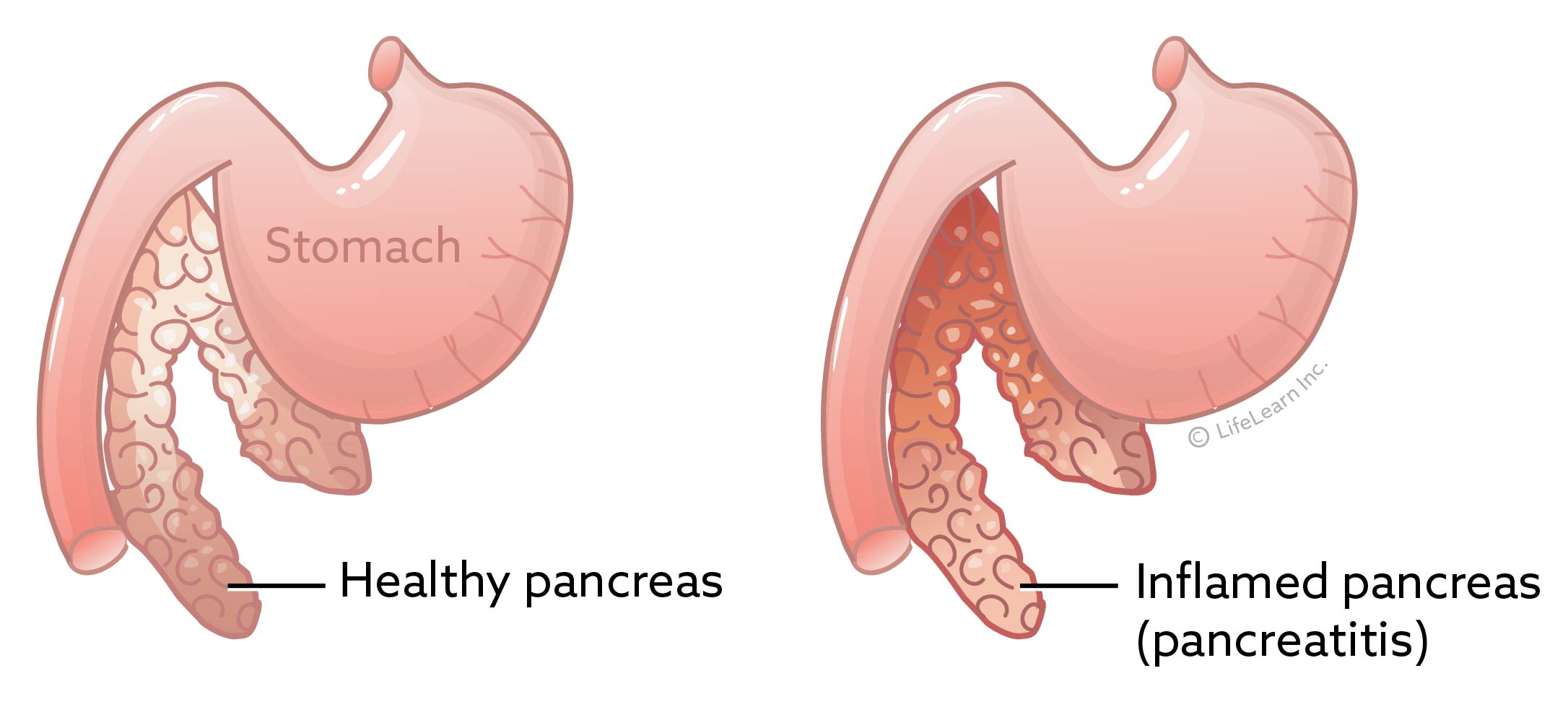Pancreatitis in Dogs
What is pancreatitis in dogs?
The pancreas is a vital organ that lies on the right side of the abdomen adjacent to the stomach. The pancreas produces enzymes to assist in food digestion and hormones such as insulin, which regulates blood sugar or glucose metabolism. The digestive enzymes are secreted into the small intestine, and the hormones enter the bloodstream.
When the pancreas becomes inflamed, the condition is called pancreatitis. Pancreatitis commonly occurs in the dog. There is no age, sex, or breed predisposition. Pancreatitis may be acute or chronic.
Acute pancreatitis may either take a mild, edematous form or a more severe, hemorrhagic form. The associated inflammation allows digestive enzymes from the pancreas to spill into the abdominal cavity resulting in secondary damage to the liver, bile ducts, gall bladder, and intestines. A few dogs that recover from an acute episode of pancreatitis may continue to have recurrent bouts of the disease, which is then called chronic or relapsing pancreatitis.

What causes pancreatitis?
Normally, pancreatic enzymes are produced in an inactive state and travel through the pancreatic duct to the duodenum, part of the small intestine. Once they reach the small intestine, they are activated to begin digestion. With pancreatitis, these enzymes are activated prematurely in the pancreas instead of later in the small intestine. Think of this as if a time-release capsule that suddenly bursts before it reaches its intended target; in this case, the pancreatic enzymes start to digest before they should. This results in digestion of the pancreas itself. The clinical signs of pancreatitis are often variable, and the intensity of the disease will depend on the amount of enzymes that were prematurely activated.
The exact cause of pancreatitis is not known, although it may be triggered in some cases by a fatty meal or corticosteroid administration. However, in many cases it appears to occur spontaneously.
What are the clinical signs of pancreatitis?
The most common clinical signs include nausea, vomiting, fever, lethargy, abdominal pain, diarrhea, and decreased appetite. During an attack, dogs may take a 'praying position', with their rear end up in the air while their front legs and head are lowered onto the floor. If the attack is severe, acute shock, severe depression, and even death may occur.

How is pancreatitis diagnosed?
Laboratory tests usually reveal an elevated white blood cell count; however, an elevated white blood cell count may also be caused by many other diseases besides pancreatitis. The elevation of pancreatic enzymes in the blood is probably the most helpful criteria in detecting pancreatic disease, but some dogs with pancreatitis will have normal enzyme levels. In recent years, a new pancreatic test has become available that can accurately diagnose pancreatitis, even if pancreatic enzymes are normal (see handout "Pancreatitis in Dogs - Pancreas-Specific Lipase"). Radiographs may show changes associated with inflammation, especially in the severe hemorrhagic form.
Ultrasound studies often provide a diagnosis of pancreatic inflammation or local peritonitis caused by this condition. Unfortunately, some dogs with pancreatitis, especially chronic pancreatitis, will escape detection with many of these tests.
Consequently, the diagnosis of pancreatitis may be tentative or presumptive in some cases and based solely on clinical signs and medical history.

How is pancreatitis treated?
The successful management of pancreatitis will depend on early diagnosis and prompt medical therapy. With mild, edematous pancreatitis, the treatment is supportive, by 'resting' the pancreas and allowing the body to heal itself. Dogs who are vomiting should be fasted until the vomiting subsides. Food can be withheld from patients for a few days if needed. Dogs who are not vomiting may be fed a low fat, highly digestible diet during recovery.
Analgesics will be given to control the intense pain and intravenous fluids will be given to maintain normal fluid and electrolyte balance. Many cases will also require anti-inflammatory drugs or medications to control vomiting or diarrhea. Antibiotics will be administered if concurrent infection is suspected.
Most dogs with pancreatitis are hospitalized for two to four days while intravenous fluids and medications are administered and food is gradually re-introduced. With severe hemorrhagic pancreatitis, or if the dog is showing signs of systemic shock, intensive care using aggressive doses of intravenous fluids and medications to counteract shock.What is the prognosis of pancreatitis?
The prognosis depends on the severity of the disease when diagnosed and the response to initial therapy. Dogs that present with shock and depression have a very guarded prognosis. Most of the mild forms of pancreatitis have a good prognosis with aggressive treatment. Dogs that are not treated may progress to the hemorrhagic form and suffer severe consequences, including sudden death.

Will there be any long-term problems?
Most dogs recover without any long-term consequences. However, with severe or repeated episodes of pancreatitis, one or more of the following problems may develop:
- If a significant number of cells that produce digestive enzymes are destroyed, a lack of proper food digestion may follow. This is known as exocrine pancreatic insufficiency (EPI) and can be treated with daily administration of an enzyme replacement powder.
- If a significant number of cells that produce insulin are destroyed, diabetes mellitus can result.
- In rare cases, painful adhesions between the abdominal organs may occur as a consequence of pancreatitis.
Dogs with chronic pancreatitis are more likely to develop the secondary conditions listed above. Management of these conditions is a very important factor in treatment success.



